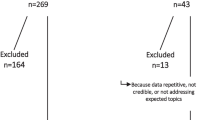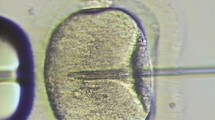Abstract
Purpose
It was studied whether morphokinetics of blastocoele re-expansion and hatching in vitrified-warmed blastocysts is predictive of implantation, clinical pregnancy, and live birth.
Methods
In 144 patients aiming for single warmed blastocyst transfer, blastocysts were cultured in a new time-lapse system (Miri® TL) immediately after warming. Video sequences with an image interval of 5 min were annotated and the corresponding morphokinetic variables were correlated with pregnancy outcome. In detail, tRE (start of re-expansion), tCRE (completion of re-expansion), tAH (hatching from the manipulated zona pellucida), and presence of collapses were recorded.
Results
In the pregnant group, tRE and tCRE were significantly lower (0.69 ± 0.45 h and 2.16 ± 0.94 h) as compared to the non-pregnant group (1.23 ± 1.08 h and 2.70 ± 1.20 h). Both variables and the duration of re-expansion (tCRE-tRE) allowed for distinction between “non-pregnant,” “loss of pregnancy,” and live birth/ongoing pregnancy. Presence and number of collapses showed no correlation with outcome.
Conclusions
Time-lapse imaging of vitrified-warmed blastocysts offers additional selection criteria allowing for prediction of implantation potential. As a consequence, cumulative pregnancy rate could be increased and time-to-pregnancy reduced.


Similar content being viewed by others
References
Liebermann J, Tucker MJ. Comparison of vitrification and conventional cryopreservation of day 5 and day 6 blastocysts during clinical application. Fertil Steril. 2005;86:20–6.
Vanderzwalmen P, Bertin G, Debauche C, Standaert V, van Roosendaal E, Vandervorst M, et al. Births after vitrification at morula and blastula stages: effect of artificial reduction of the blastocoelic cavity before vitrification. Hum Reprod. 2002;17:744–51.
Vanderzwalmen P, Bertin G, Debauche C, Standaert V, Bollen N, van Roosendaal E, et al. Vitrification of human blastocysts with the Hemi-straw carrier: application of assisted hatching after thawing. Hum Reprod. 2003;18:1504–11.
Ortega-Hrepich C, Stoop D, Guzmán L, Van Landuyt L, Tournaye H, Smitz J, et al. A “freeze-all” embryo strategy after in vitro maturation: a novel approach in women with polycystic ovary syndrome. Fertil Steril. 2013;100:1002–7.
Shapiro BS, Daneshmand ST, Garner FC, Aguirre M, Hudson C. Freeze-all at the blastocyst or bipronuclear stage: a randomized clinical trial. Fertil Steril. 2015;104:1138–44.
Stoop D, Van Landuyt L, Van den Abbeel E, Camus M, Verheyen G, Devroey P. Should a single blastocyst transfer policy be a clinical decision or should it depend on the embryological evaluation on day 3? Reprod Biol Endocrinol. 2011;9:60. doi:10.1186/1477-7827-9-60.
Zander-Fox DL, Tremellen K, Lane M. Single blastocyst embryo transfer maintains comparable pregnancy rates to double cleavage-stage embryo transfer but results in healthier pregnancy outcomes. Aust N Z J Obstet Gynaecol. 2011;51:406–10.
Ebner T, Vanderzwalmen P, Shebl O, Urdl W, Moser M, Zech NH, et al. Morphology of vitrified/warmed day-5 embryos predicts rates of implantation, pregnancy and live birth. Reprod Biomed Online. 2009;19:72–8.
Ebner T, Vanderzwalmen P, Wirleitner B. Atlas of vitrified blastocysts in human assisted reproduction. 1st ed. Cambridge: Cambridge University Press; 2015.
Shu Y, Watt J, Gebhardt J, Dasig J, Appling J, Behr B. The value of fast blastocyst re-expansion in the election of a viable thawed blastocyst for transfer. Fertil Steril. 2008;91:401–6.
Van den Abbeel E, Camus M, Verheyen G, Van Waesberghe L, Devroey P, Van Steirteghem A. Slow controlled-rate freezing of sequentially cultured human blastocysts: an evaluation of two freezing strategies. Hum Reprod. 2005;20:2929–45.
Maezawa T, Yamanaka M, Hashimoto S, Amo A, Ohgaki A, Nakaoka Y, et al. Possible selection of viable human blastocysts after vitrification by monitoring morphological changes. J Assist Reprod Genet. 2014;31:1099–104.
ALPHA Scientists in Reproductive Medicine, ESHRE Special Interest Group Embryology. Istanbul consensus workshop on embryo assessment: proceedings of an expert meeting. Reprod Biomed Online. 2011;22:632–46.
Ebner T, Moser M, Tews G. Possible applications of a non-contact 1.48 microm wavelength diode laser in assisted reproduction technologies. Hum Reprod Update. 2005;11:425–35.
Biggers JD, Bell JE, Benos DJ. Mammalian blastocyst: transport functions in a developing epithelium. Am J Physiol. 1988;255:C419–32.
Veeck LL, Zaninovic N. An atlas of human blastocysts. 1st ed. Boca Raton, London, New York, Washington: Parthenon Publishing; 2003.
Marcos J, Pérez-Albalá S, Mifsud A, Molla M, Landeras J, Meseguer M. Collapse of blastocysts is strongly related to lower implantation success: a time-lapse study. Hum Reprod. 2015;30:2501–8.
Bodri D, Sugimoto T, Yao Serna J, Kawachiya S, Kato R, Matsumoto T. Blastocyst collapse is not an independent predictor of reduced live birth: a time-lapse study. Fertil Steril. 2016;105:1476–83.e3.
Shimoda Y, Kumagai J, Anzai M, Kabashima K, Togashi K, Miura Y, et al. Time-lapse monitoring reveals that vitrification increases the frequency of contraction during the pre-hatching stage in mouse embryos. J Reprod Dev. 2016;62:187–93.
Mirzazadeh F, Cater E, Nice L, Campbell A. Data analysis study on the rate of blastocyst re-expansion after warming and its significance to outcome. Reprod Biomed Online. 2016;32(1):9.
Galán Rivas A, Coello A, Cobo A, Nohales M, Alegre L, Meseguer M. Morphology dynamics of warmed blastocysts are strong predictors of clinical outcome. Hum Reprod. 2016, in press.
Acknowledgments
The authors would like to thank G. Schappacher-Tilp for statistical expertise.
Author information
Authors and Affiliations
Corresponding author
Additional information
Capsule Time-lapse imaging of vitrified-warmed blastocysts, particularly the start of re-expansion, offers additional selection criteria allowing for prediction of implantation potential which may result in reduced time-to-pregnancy.
Rights and permissions
About this article
Cite this article
Ebner, T., Oppelt, P., Radler, E. et al. Morphokinetics of vitrified and warmed blastocysts predicts implantation potential. J Assist Reprod Genet 34, 239–244 (2017). https://doi.org/10.1007/s10815-016-0855-5
Received:
Accepted:
Published:
Issue Date:
DOI: https://doi.org/10.1007/s10815-016-0855-5




